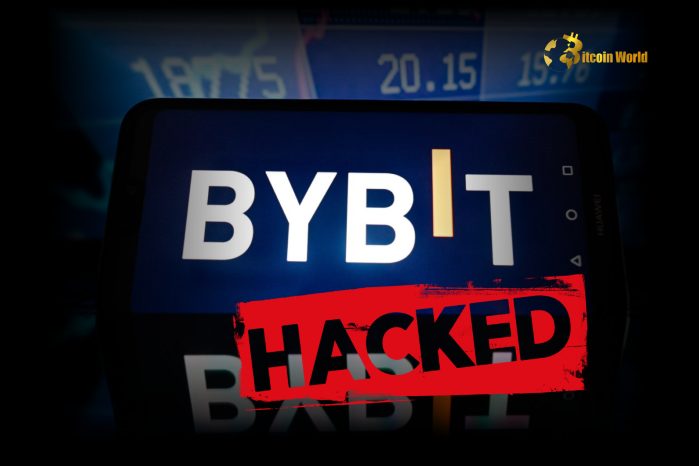
BTC price drops below 97,000 dollars, affecting altcoins significantly. ByBit`s recent hack raises concerns over liquidity and market stability. Continue Reading: Market Turbulence Triggers Sudden Drops in Cryptocurrency Prices The post Market Turbulence Triggers Sudden Drops in Cryptocurrency Prices appeared first on COINTURK NEWS .
CoinTurk News
You can visit the page to read the article.
Source: CoinTurk News
Disclaimer: The opinion expressed here is not investment advice – it is provided for informational purposes only. It does not necessarily reflect the opinion of BitMaden. Every investment and all trading involves risk, so you should always perform your own research prior to making decisions. We do not recommend investing money you cannot afford to lose.
Extreme Bitcoin DXY Correlation: Is This a Golden Opportunity or a Warning Sign?

Is the crypto market mirroring traditional finance more closely than we think? Recent analysis suggests a fascinating, and potentially critical, relationship between Bitcoin and the U.S. Dollar Index (DXY). According to Jamie Coutts, a respected analyst from Real Vision, the inverse correlation between Bitcoin and the DXY has reached extreme levels. This intriguing development could signal significant shifts in global liquidity and market dynamics, creating both opportunities and challenges for crypto investors. Let’s dive deep into what this means for your crypto portfolio and the broader market. Decoding the Bitcoin DXY Correlation: What’s the Hype? For those new to market analysis, understanding the Bitcoin DXY correlation is crucial. The DXY, or U.S. Dollar Index, measures the dollar’s strength against a basket of six major world currencies. Historically, Bitcoin, often seen as a hedge against traditional financial systems, has exhibited an inverse relationship with the DXY. This means when the dollar weakens, Bitcoin tends to rise, and vice versa. But why is this happening now, and why is it considered ‘extreme’? Jamie Coutts highlighted this unusual situation on X, noting that the current Bitcoin inverse correlation with the DXY is reaching levels rarely seen before. He suggests that while a weaker dollar is generally seen as favorable for risk assets like Bitcoin, political factors are currently exerting influence on the DXY. This creates a complex scenario that demands careful attention from investors. Why is the Inverse Correlation Between Bitcoin and DXY Important? Understanding this correlation offers valuable insights into broader market trends and potential investment strategies. Here’s why this relationship matters: Global Liquidity Indicator: A weakening dollar often signals increased global liquidity. When the DXY falls, it generally becomes cheaper for other countries to borrow and invest in dollar-denominated assets, including cryptocurrencies. Risk-On/Risk-Off Sentiment: A strong dollar often indicates a “risk-off” environment, where investors flock to the safety of the dollar. Conversely, a weaker dollar can suggest a “risk-on” sentiment, encouraging investment in riskier assets like Bitcoin. Investment Strategy Implications: Monitoring the DXY impact on Bitcoin correlation can help investors anticipate potential market movements and adjust their portfolios accordingly. An extreme correlation could indicate either an overextended market condition or an impending significant shift. To illustrate, consider a simplified scenario: DXY Trend Typical Bitcoin Reaction Market Sentiment DXY Decreases (Dollar Weakens) Bitcoin Price Tends to Increase Risk-On DXY Increases (Dollar Strengthens) Bitcoin Price Tends to Decrease Risk-Off Political Factors and the Dollar: What’s Influencing DXY? Coutts points out that political factors are playing a significant role in the current DXY dynamics. This is a crucial element to consider because traditional economic models might not fully capture the impact of geopolitical events on currency valuations. These political influences can include: Geopolitical Instability: Global events, such as conflicts or political uncertainty, can drive investors towards the perceived safety of the U.S. dollar, strengthening the DXY. US Fiscal Policy: Government spending and debt levels can influence investor confidence in the dollar. Aggressive fiscal policies might weaken the dollar over time. Federal Reserve Policy: Interest rate decisions and monetary policy by the Federal Reserve are primary drivers of dollar strength. Hawkish policies tend to strengthen the dollar, while dovish policies can weaken it. These political and economic factors are creating a tug-of-war, potentially contributing to the ‘extreme’ correlation observed. It’s not just about typical market forces; external pressures are adding layers of complexity to the DXY impact on Bitcoin . The Critical Level: 106 on the DXY Coutts specifically mentions the 106 level on the DXY as a critical threshold. He suggests that a drop below 106 would be a “strong bullish signal for global liquidity.” Why is this level so important? Technical Indicator: 106 likely represents a significant support level for the DXY. Breaking below this level could indicate a sustained weakening of the dollar. Liquidity Release: A weaker dollar, as discussed, typically translates to increased global liquidity. This liquidity often flows into various markets, including cryptocurrencies, potentially boosting Bitcoin’s price. Market Confidence: Breaching a key support level can also shift market sentiment. A DXY drop below 106 might instill greater confidence in risk assets and trigger further investment in Bitcoin. Therefore, keeping a close watch on the DXY, particularly around the 106 mark, is vital for anyone involved in the crypto market. This level could act as a key trigger for significant market movements and shifts in the Bitcoin DXY correlation . Navigating the Extreme Correlation: Actionable Insights for Crypto Investors So, what should crypto investors do with this information? Here are some actionable insights based on the current Bitcoin market analysis and the extreme DXY correlation: Monitor DXY Closely: Keep an eye on the U.S. Dollar Index, especially the 106 level. Use financial websites or trading platforms to track its movement in real-time. Diversify Your Portfolio: While Bitcoin shows a strong inverse correlation, diversification remains key. Don’t put all your eggs in one basket. Explore other cryptocurrencies and asset classes to mitigate risk. Stay Informed on Global Politics: Be aware of major geopolitical events and policy changes that could influence the dollar and, consequently, Bitcoin. Use Technical Analysis: Combine DXY analysis with other technical indicators for Bitcoin to make informed trading decisions. Look at Bitcoin’s price charts in conjunction with DXY movements. Manage Risk: Extreme correlations can sometimes revert to the mean. Be prepared for potential shifts in the relationship and manage your risk accordingly. Don’t overextend your positions based solely on this correlation. Is This Extreme Correlation a Golden Opportunity? The current crypto market signals are mixed but intriguing. While an extreme inverse correlation might seem like a straightforward bullish signal for Bitcoin if the DXY weakens, it’s essential to approach with caution. ‘Extreme’ conditions are often unsustainable and can be followed by sharp corrections or shifts in market dynamics. However, this situation also presents a potential golden opportunity. If Coutts is correct and a DXY drop below 106 unleashes significant global liquidity, Bitcoin could indeed see a substantial upward movement. The key is to be prepared, stay informed, and manage risk effectively. This period of extreme correlation could be a time of significant profit potential for those who understand and navigate it wisely. Conclusion: Riding the Waves of Correlation The extreme inverse correlation between Bitcoin and the DXY is a powerful reminder of the interconnectedness of global markets. Jamie Coutts’ analysis highlights a critical juncture where political factors and traditional market dynamics are converging to create unique opportunities and risks in the crypto space. By understanding the Bitcoin DXY correlation , monitoring key levels like 106 on the DXY, and staying informed about broader market influences, investors can better navigate these complex waters and potentially capitalize on the evolving market landscape. The current situation demands vigilance and informed decision-making, but for those prepared, the rewards could be substantial. To learn more about the latest crypto market trends, explore our article on key developments shaping Bitcoin price action. CoinTurk News

Urgent Relief: Bybit Withdrawals Fully Restored After Lazarus Group Hack, Security Overhaul Coming
In a sigh of relief for Bybit users, CEO Ben Zhou has officially announced the complete restoration of the exchange’s withdrawal system. This welcome news follows a challenging period sparked by a significant security breach. If you were among those anxiously awaiting access to your funds on Bybit, you can now breathe easy. But what exactly happened, and what steps are being taken to prevent future incidents and enhance crypto exchange security ? Let’s dive into the details of this developing story. Bybit Withdrawals Back Online: What Happened? The crypto world was recently shaken by news of a substantial hack targeting Bybit, with reports indicating a staggering $1.46 billion in ETH stolen from their cold wallets. Attribution pointed towards North Korea’s notorious Lazarus Group, known for their sophisticated cybercriminal activities. This attack understandably caused panic and disruption, leading to temporary suspension of Bybit withdrawals . Here’s a quick rundown of the key events: Security Breach: Bybit experienced a sophisticated cold wallet hack, allegedly perpetrated by the Lazarus Group. Withdrawal Suspension: As a precautionary measure, Bybit temporarily halted withdrawals to address the security vulnerability and secure user funds. Swift Response: The Bybit team worked diligently to investigate the breach, restore the withdrawal system, and implement enhanced security protocols. Full Restoration: CEO Ben Zhou confirmed via X (formerly Twitter) that Bybit withdrawals are now fully operational, with all pending requests processed without delay. CEO Ben Zhou’s Assurance: More Security Measures on the Horizon In his official announcement, Ben Zhou , CEO of Bybit, conveyed a message of transparency and reassurance. He apologized for the inconvenience caused by the withdrawal suspension and expressed gratitude to the Bybit community for their patience and support. Crucially, Zhou emphasized that this incident is a catalyst for strengthening Bybit’s security infrastructure. Here are the key takeaways from Ben Zhou’s statement: Withdrawals Fully Restored: The primary message is clear – users can now access their funds without any issues. Incident Report Coming: Bybit is committed to transparency and will release a detailed incident report outlining the events that transpired. New Security Measures: Zhou promised the imminent implementation of enhanced security measures to prevent similar incidents in the future and bolster overall crypto exchange security . Gratitude and Commitment: He thanked users, partners, and friends for their support, acknowledging that strengthening security is an ongoing process. Lazarus Group Hack: A Stark Reminder of Crypto Security Threats The alleged involvement of the Lazarus Group hack in this incident underscores the persistent and evolving threats within the cryptocurrency space. The Lazarus Group, a North Korean state-sponsored hacking organization, is notorious for targeting financial institutions and cryptocurrency platforms to generate revenue for the regime. Their methods are sophisticated, often involving advanced persistent threats (APTs) and meticulous planning. This incident serves as a potent reminder of several critical aspects: Cold Wallet Vulnerabilities: Even cold wallets, designed for offline storage and enhanced security, are not entirely impervious to sophisticated attacks. State-Sponsored Actors: The involvement of state-sponsored groups like the Lazarus Group signifies the high stakes and resources involved in cryptocurrency cybercrime. Importance of Vigilance: Both exchanges and individual users must remain vigilant and proactive in adopting robust security practices to mitigate risks. Ongoing Security Evolution: The cybersecurity landscape is constantly changing, requiring continuous adaptation and improvement of security measures within the crypto industry. Strengthening Crypto Security Measures: What Can Exchanges Do? In the wake of incidents like the Lazarus Group hack targeting Bybit, the spotlight intensifies on the crucial need for robust crypto security measures . What concrete steps can cryptocurrency exchanges take to safeguard user assets and maintain trust in the ecosystem? Here are some key areas of focus: Security Measure Description Benefit Multi-Signature Wallets Requiring multiple private keys to authorize transactions, adding layers of security. Reduces single points of failure and makes unauthorized access significantly harder. Regular Security Audits Independent security firms conduct thorough assessments of systems and infrastructure. Identifies vulnerabilities and weaknesses before they can be exploited by malicious actors. Advanced Intrusion Detection Systems Real-time monitoring of network traffic and system activity to detect and respond to threats. Enables rapid response to security breaches, minimizing potential damage. Employee Security Training Educating employees about phishing attacks, social engineering, and secure coding practices. Reduces human error, a significant factor in many security breaches. Bug Bounty Programs Incentivizing ethical hackers to identify and report security vulnerabilities. Leverages the wider security community to proactively find and fix weaknesses. Enhanced KYC/AML Procedures Strengthening Know Your Customer (KYC) and Anti-Money Laundering (AML) processes. Helps prevent illicit activities and reduces the risk of the platform being used for illegal purposes. Actionable Insights: What Crypto Users Should Consider While exchanges bear the primary responsibility for platform security, individual users also play a vital role in safeguarding their crypto assets. Here are some actionable insights for crypto users to enhance their personal security: Use Strong, Unique Passwords: Employ complex passwords and avoid reusing them across multiple platforms. Consider using a password manager. Enable Two-Factor Authentication (2FA): Activate 2FA on all crypto exchange accounts and wallets for an extra layer of security. Be Phishing Aware: Exercise caution with emails, messages, and links, especially those requesting personal information or login credentials. Use Hardware Wallets: For long-term storage of significant crypto holdings, consider using hardware wallets for offline cold storage. Stay Informed: Keep up-to-date with the latest security news and best practices in the cryptocurrency space. Conclusion: A Renewed Focus on Crypto Exchange Security Bybit’s swift response to the security breach and the full restoration of Bybit withdrawals are positive developments. However, the incident, allegedly linked to the Lazarus Group hack , serves as a critical wake-up call for the entire cryptocurrency industry. The promise of enhanced security measures from Bybit, and hopefully from other exchanges as well, signals a renewed commitment to protecting user assets and fostering a more secure crypto ecosystem. As the industry matures, prioritizing robust security will be paramount to building trust and ensuring the long-term viability of cryptocurrencies. To learn more about the latest crypto market trends, explore our article on key developments shaping Bitcoin price action. CoinTurk News











